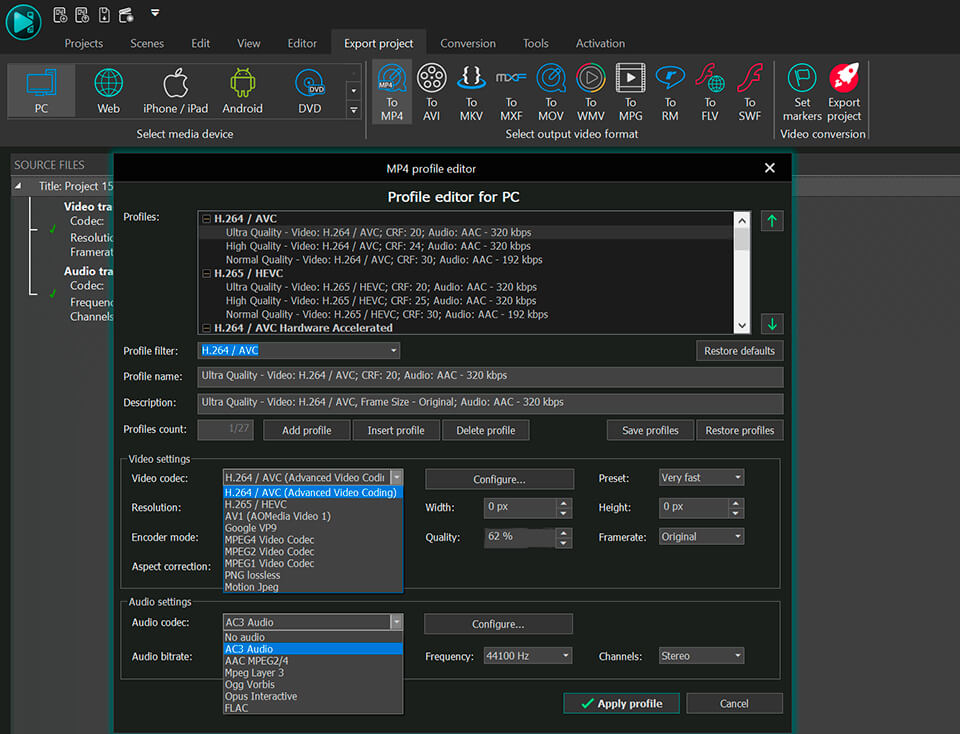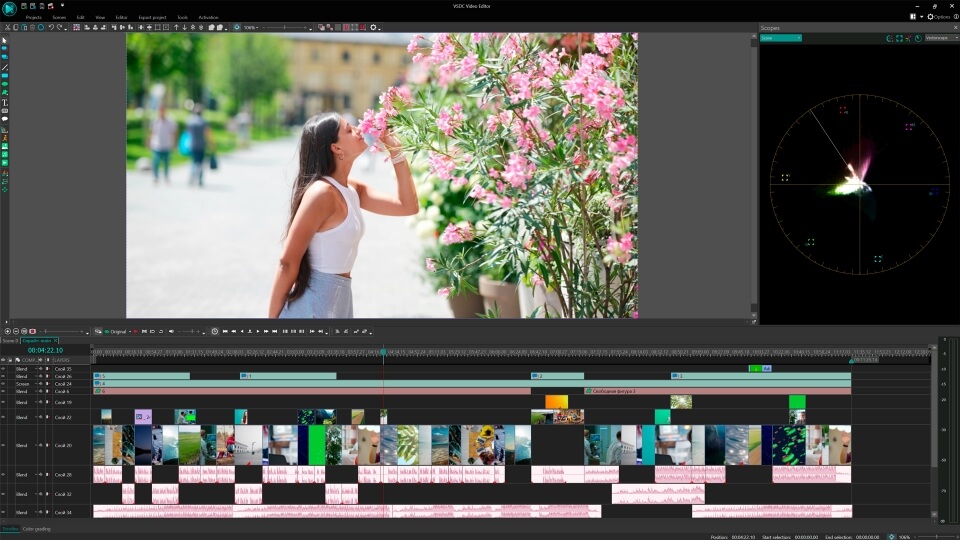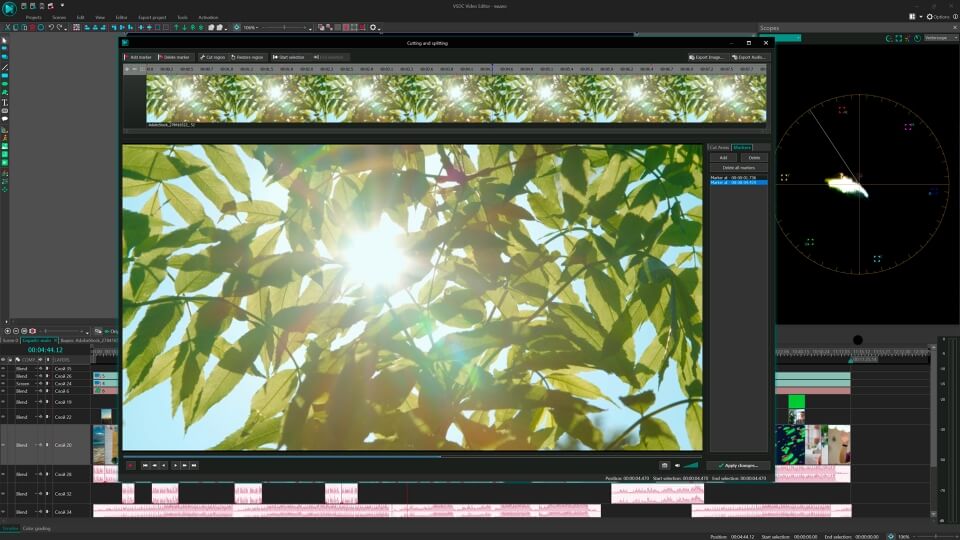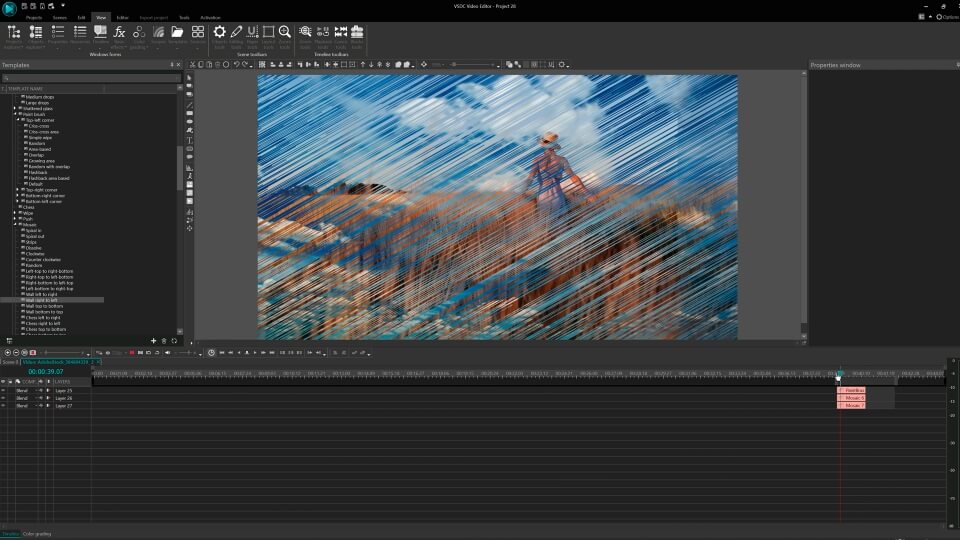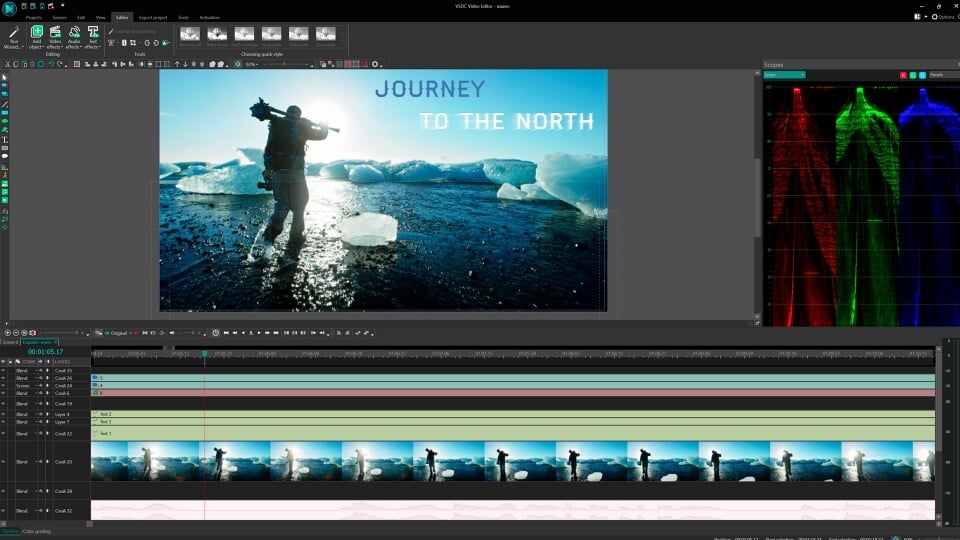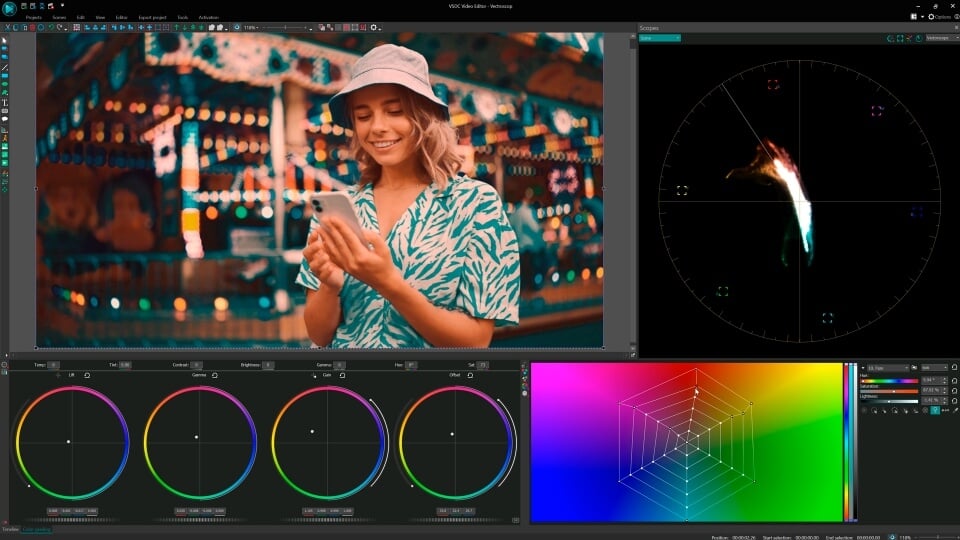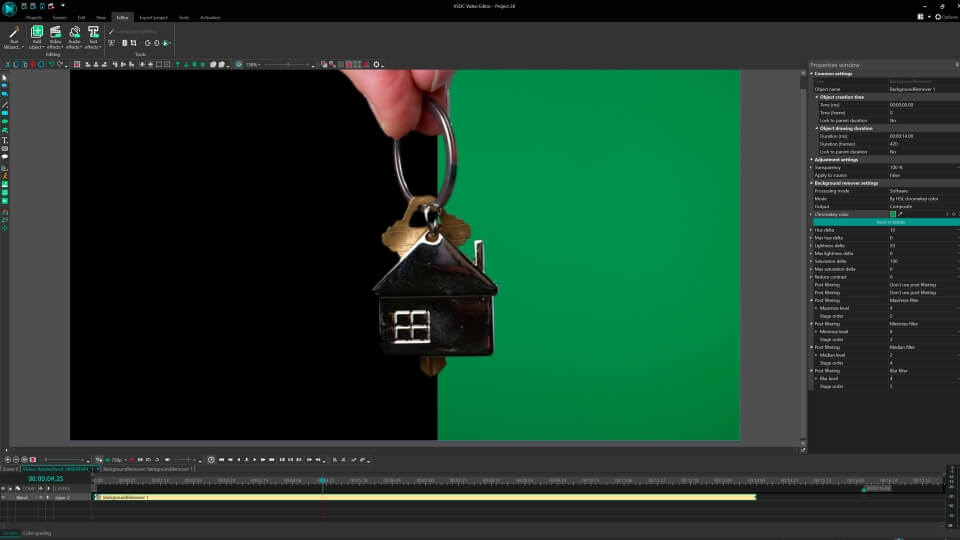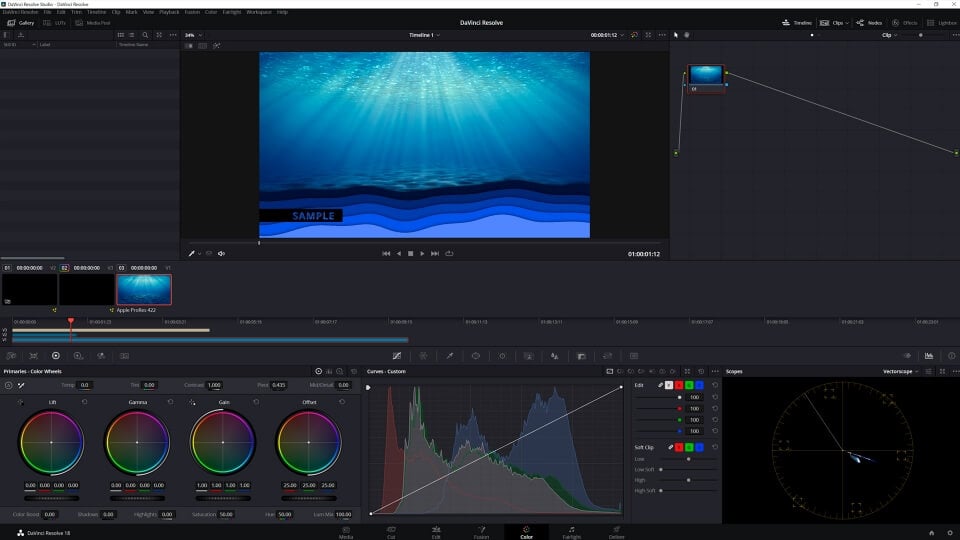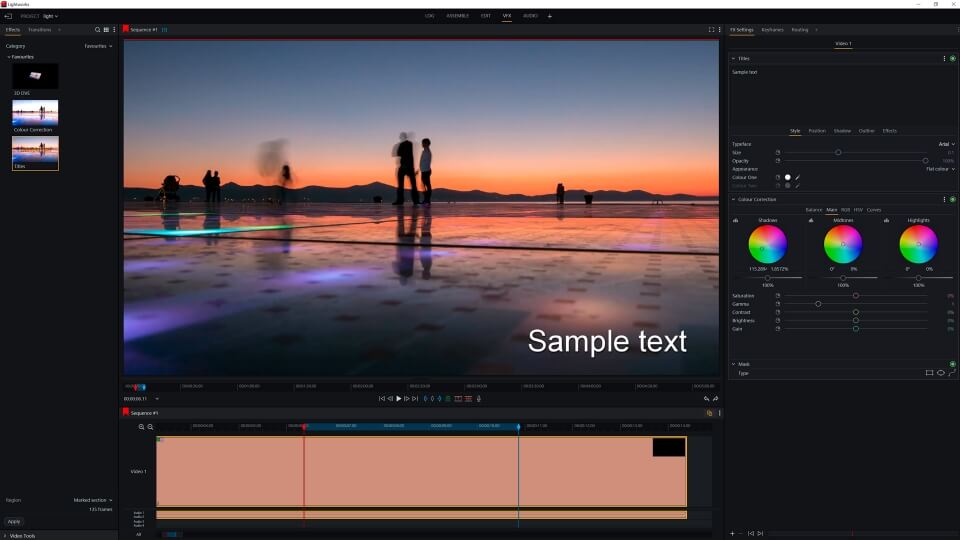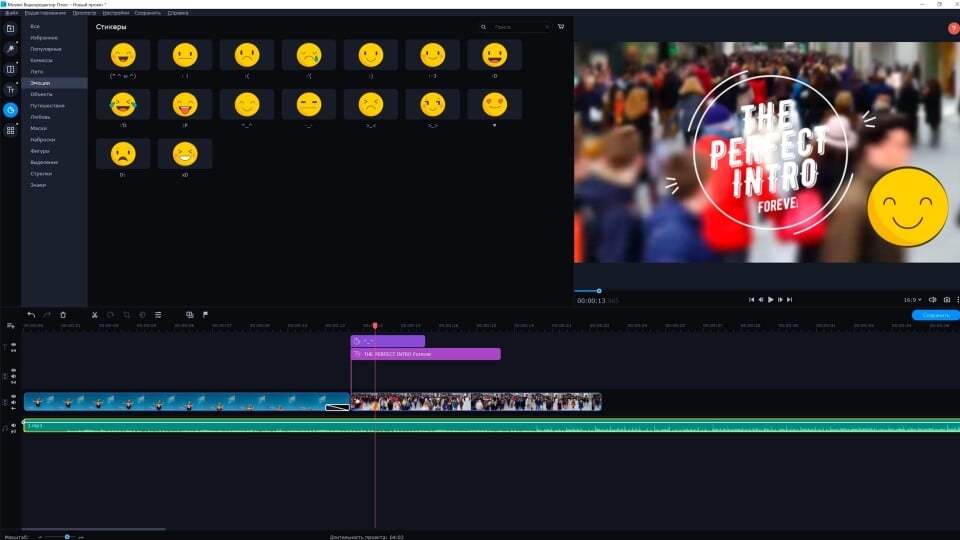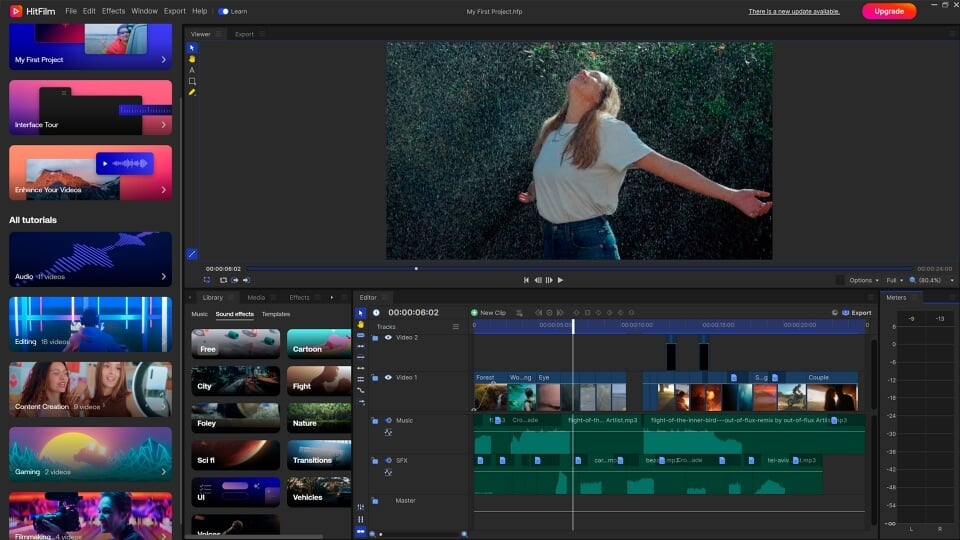Video Editor
Use free video software to create and edit videos of any complexity from a family greeting card to a company presentation. Cut, merge video files, apply visual and audio effects, use filtration and image correction, make slideshows and add an appropriate soundtrack. Use multi-color Chroma Key and advanced parameters settings to give your video a professional look. All popular video and audio formats are supported.
Video Converter
This program is intended for converting video files from one format to another. Nearly all popular video formats are supported (both reading and saving). In addition, the program drastically simplifies the task of converting videos for playback on specific multimedia devices, such as iPhone, Samsung Galaxy or Huawei P30 Pro. The program is extremely easy to use, has a modern interface and all necessary video processing functions.
Audio Converter
The audio converter will help you convert audio files from one format to another. All key audio formats and codecs are supported. The program also allows you to manage playlists and meta tags, extract audio from video files and save these tracks on your computer in any format.
Audio CD Grabber
This audio tool is intended for grabbing audio tracks from compact discs and saving them to the user’s computer in any format. Nearly all popular audio formats and codecs are supported. The program can also extract track details from the FreeDB server for automatic file renaming and updating meta tags.
Video Editor
Video Converter
Audio Converter
Audio CD Grabber

Multifunctionality
A wide array of multimedia processing tools in one free video software suite.

High speed
Our programs use fast
and high-quality algorithms optimized for single and multi-core CPU’s.

Affordability
VSDC video software is freely available for download to Windows OS-based PCs and laptops.
- This holiday season embraces new beginnings with the latest update of VSDC Video...
- Change is all about improvement, and this process wouldn't be possible without y...
- Intro In 2024 the options range for creating visual effects is incredibly dive...
- Are you ready to explore new heights with the latest major VSDC update? Finally,...
How Black and White Movies Were Colorized
Are you a fan of classic black and white films? Ever been curious about how they would appear if they were in color? Many filmmakers have pondered the same, leading to numerous classic movies being colorized. Over the years, the technique for adding color to black and white movies has significantly advanced — from manually painting each frame to using cutting-edge software that colors each pixel automatically, significantly speeding up the process. Today we’ll see how colorization works, exploring how yesterday's black and white movies that we enjoy so much are reimagined in full, vivid color and learn how to enhance similar color techniques in VSDC Video Editor.
Key Takeaways
- Early Colorization Techniques (1890s-1960s);
- The Rise of Digital Colorization (1970s-Present);
- Helpful Ideas of How to Work with Color in VSDC;
- FAQ.
Early Colorization Techniques (1890s-1960s)
The dawn of color films dates back to around 1895. Initially, color brought to black and white films served as a "special effect" that captivated and attracted audiences and critics alike. Before the introduction of Technicolor, which later captured a full spectrum of lifelike colors, early colorists did their best to explore available techniques and experiment.
Interesting point: Costumes, scenery and makeup in these films were selected for their effectiveness in black-and-white rather than their realism and sometimes looked rather strange when shooting. For example, Alfred Hitchcock used chocolate syrup instead of stage blood for better effect in black and white in his movies. If "Psycho" was colorized with modern techniques, the program would interpret the "blood" as chocolate brown instead of red. Given these constraints, colorists undertook extensive research to accurately select color palettes. They analyzed the film's dialogue for contextual clues, conducted historical research, and consulted with individuals involved in the original production.
However, the process was expensive: the cost of colorizing a full-length black and white movie amounted to around $350,000 since the earliest methods of film colorization were entirely done by hand directly onto film strips. The first full-length feature film made by this hand-coloring process premiered in 1912. This manual coloring process persisted into the 1920s, sometimes involving stencils cut from a second print of the film for guidance. Techniques like this were used for individual shots and, on rare occasions, an entire feature-length film, demonstrating the extensive efforts and artistic dedication in the early days of cinema colorization.
The Rise of Digital Colorization (1970s-Present)
By the mid-1980s, progress in computer technology made it possible to colorize black and white movies and TV shows. Proponents of this technology argued that adding color made these old classics more appealing to contemporary audiences, potentially reviving their popularity and creating new revenue streams through television syndication and VHS sales. Nevertheless, audiences were thrilled to see their favorite black-and-white movies in color: Roger L. Mayer, president and COO of Turner Entertainment Co., testified before the Senate in 1988 that the audience for these colorized versions was five to ten times larger than that of their black and white counterparts over the previous twenty years.
The process of colorization was primarily carried out by two companies, Color Systems Technology, Inc. and Colorization, Inc., using a similar method. This involved digitally scanning the film and decomposing the first frame of each scene into pixels. The software would then analyze the gray values to infer the original colors used during filming. Once these colors were determined, they would be consistently applied to the corresponding pixels until the scene changed. This digital approach streamlined the colorization process, allowing for more efficient handling of the extensive frames involved in film, thereby modernizing the accessibility and appearance of historical cinematic works.
Helpful Ideas of How to Work with Color in VSDC
Nowadays, advanced AI tools are employed to colorize black and white movies, a task generally reserved for professionals due to copyright concerns. Despite this, VSDC Video Editor offers various techniques for creatively working with color and combining black and white elements in your footage or music video to provide a fresh perspective.
Within VSDC, you can:
- Adjust Brightness and Contrast: Utilize RGB curves to fine-tune the brightness and contrast of your video, enabling precise color grading;
- Advanced Color Correction: Take advantage of the Scopes window, Vectorscope, Hue, Saturation, Value effects and Lift, Gamma & Gain color wheels to make sophisticated color adjustments;
- Work with Color Keyframes: This feature lets you create your own effects by modifying colors dynamically over time;
- Create a Complex VHS Effect: Recreate the nostalgic look of VHS recordings with a series of adjustments and effects;
- Isolate Color: Create a black and white video highlighting one colorful object;
- Recreate Color Corrections from Famous Movies: Try your hand at mimicking the color grading seen in well-known films like Barbie or Oppenheimer).
These tools make VSDC a formidable option for both amateur and professional video editors looking to elevate the visual quality of video projects.
Wrapping up
The practice of colorizing black and white movies is a contentious one, as it can alter the original artistic intentions of the filmmakers. While some argue that this process detracts from the aesthetic and historical value of these films, others believe it enhances accessibility for modern audiences by breathing new life into classic cinema. Colorization requires a delicate balance of artistic skill, historical research, and technical expertise to achieve a result that is both convincing and visually appealing.
While film colorization may not be as essential today, VSDC, a leading video editor for Windows, allows users to apply filters, perform color corrections, and experiment with color isolation. These features enable filmmakers and enthusiasts to enhance and modernize their videos while still honoring and preserving the original artistry. For further assistance, reach out to us on social networks on Facebook, YouTube, or at This email address is being protected from spambots. You need JavaScript enabled to view it..
FAQ
How Black and White Movies Were Colorized?
The process is known as film colorization where old black-and-white movies are first converted into a digital format and then, with the help of computer software, individual objects are colorized one frame at a time.
How long does it take to colorize a black and white movie?
The overall time of colorizing black and white movies may vary based on the length of the film and the method used. Hand-painting each frame, the original method, could take months or even years for a feature-length film while digital colorization is faster but still labor-intensive; it can take several weeks to several months to complete.
Are there any black and white movies that were originally filmed in color but released in black and white?
Yes, there are indeed instances where movies were originally filmed in color but were released in black and white, often due to artistic decisions or distribution strategies. A notable example is "The Mist" (2007), directed by Frank Darabont. While primarily released in color, Darabont preferred the black and white version, which he felt better captured the intended bleak, moody atmosphere of the film, reminiscent of old TV horror shows and movies. This version is available on DVD as a special feature.

This program allows you to capture the video of your desktop and save it on your PC in various formats. Coupled with a video editor, the program is a great tool for creating presentations, tutorials and demo videos.

The program captures video from external devices and records it to computer in a free format. You can save video from video tuners, webcams, capture cards and other gadgets.

"VSDC Free Video Editor is a surprisingly powerful, if unconventional video editor"
- PC Advisor

"This video editor gives you tons of control and editing power"
- CNet

"The editor handles many common formats and boasts a good deal of capabilities when it comes time to alter lighting, splice video, and apply filters and transitions in post production"
- Digital Trends
